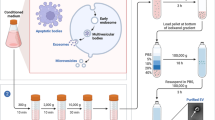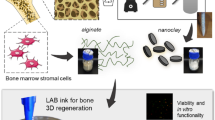Abstract
The human amniotic membrane (HAM) is an abundant and readily obtained tissue that may be an important source of scaffold for transplanted chondrocytes in cartilage regeneration in vivo. To evaluate the potential use of cryopreserved HAMs as a support system for human chondrocytes in human articular cartilage repair. Chondrocytes were isolated from human articular cartilage, cultured and grown on the chorionic basement membrane side of HAMs. HAMs with chondrocytes were then used in 44 in vitro human osteoarthritis cartilage repair trials. Repair was evaluated at 4, 8 and 16 weeks by histological analysis. Chondrocytes cultured on the HAM revealed that cells grew on the chorionic basement membrane layer, but not on the epithelial side. Chondrocytes grown on the chorionic side of the HAM express type II collagen but not type I, indicating that after being in culture for 3–4 weeks they had not de-differentiated into fibroblasts. In vitro repair experiments showed formation on OA cartilage of new tissue expressing type II collagen. Integration of the new tissue with OA cartilage was excellent. The results indicate that cryopreserved HAMs can be used to support chondrocyte proliferation for transplantation therapy to repair OA cartilage.







Similar content being viewed by others
References
Blanco FJ, Guitian R, Vázquez-Martul E et al (1998) Osteoarthritis chondrocytes death by apoptosis.: a posible pathway for OA pathology. Arthritis Rheum 41:284–289
Brandt KD, Mazzuca SA (2006) Experience with a placebo-controlled randomized clinical trial of a disease-modifying drug for osteoarthritis: the doxycycline trial. Rheum Dis Clin North Am 32:217–234
Brittberg M, Lindahl A, Nilsson A et al (1994) Treatment of deep cartilage defects in the knee with autologous chondrocyte transplantation. N Engl J Med 331:889–895
Brooks PM (2002) Impact of osteoarthritis on individuals and society: how much disability? Social consequences and health economic implications. Curr Opin Rheumatol 14:573–577
Froger-Gaillard B, Charrier AM, Thenet S et al (1989) Growth-promoting effects of acidic and basic fibroblast growth factor on rabbit articular chondrocytes aging in culture. Exp Cell Res 183:388–398
Fuentes Boquete IM, López Armada MJ (2007) Métodos de estudio del cartílago articular y hueso: métodos histológicos. In: Blanco FJ, Cañete JD, Pablos JL (eds) Técnicas de investigación básica en reumatología. Editorial Médica Panamericana, Madrid, pp 202–203
Galindo EEH, Theiss C, Steuhl K et al (2003) Gap junctional communication in microinjected human limbal and peripheral corneal epithelial cells cultured on intact amniotic membrane. Exp Eye Res 76:303–314
Gimeno Longas MJ, de la Mata Llord J (2007) Métodos de estudio del cartílago articular y hueso: métodos celulares. In: Blanco FJ, Cañete JD, Pablos JL (eds) Técnicas de investigación básica en reumatología. Editorial Médica Panamericana, Madrid, p 190
Hennerbichler S, Reichl B, Pleiner D et al (2007) The influence of various storage conditions on cell viability in amniotic membrane. Cell Tissue Bank 8:1–8
Ishiguro N, Kojima T, Poole R (2002) Mechanism of cartilage destruction in osteoarthritis. Nagoya J Med Sci 65:73–84
Jin CZ, Park SR, Choi BH et al (2007) Human amniotic membrane as a delivery matrix for articular cartilage repair. Tissue Eng 13:693–702
Koga H, Shimaya M, Muneta T et al (2008) Local adherent technique for transplanting mesenchymal stem cells as a potential treatment of cartilage defect. Arthritis Res Ther 10:R84
Koizumi N, Cooper LJ, Fullwood NJ et al (2002) An evaluation of cultivated corneal limbal epithelial cells, using suspension culture. Invest Ophthalmol Vis Sci 43:2114–2121
Kuo CK, Li WJ, Mauck RL et al (2006) Cartilage tissue engineering: its potential and uses. Curr Opin Rheumatol 18:64–73
Li W, He H, Kuo CL et al (2006) Basement membrane dissolution and reassembly by limbal corneal epithelial cells expanded on amniotic membrane. Invest Ophthalmol Vis Sci 47:2381–2389
Ma Y, Xu Y, Xiao Z et al (2006) Reconstruction of chemically burned rat corneal surface by bone marrow-derived human mesenchymal stem cells. Stem Cells 24:315–321
Madhira SL, Vemuganti G, Bhaduri A et al (2008) Culture and characterization of oral mucosal epithelial cells on human amniotic membrane for ocular surface reconstruction. Mol Vis 14:189–196
Mankin HJ (1982) The response of articular cartilage to mechanical injury. J Bone Joint Surg Am 64:460–466
Meller D, Pires RT, Mack RJ et al (2000) Amniotic membrane transplantation for acute chemical or thermal burns. Ophthalmology 107:980–989
Meller D, Pires RTF, Tseng SCG (2002) Ex vivo preservation and expansion of human limbal epithelial stem cells on amniotic membrane cultures. Br J Ophthalmol 86:463–471
Minas T, Chiu R (2000) Autologous chondrocyte implantation. Am J Knee Surg 13:41–50
Morton KE, Dewhurst CJ (1986) Human amnion in the treatment of vaginal malformations. Br J Obstet Gynaecol 93:50–54
Niknejad H, Peirovi H, Jorjani M et al (2008) Properties of the amniotic membrane for potential use in tissue engineering. Eur Cell Mater 15:88–99
Rendal-Vázquez ME, Maneiro-Pampín E, Rodríguez-Cabarcos M et al (2001) Effect of cryopreservation on human articular chondrocyte viability, proliferation, and collagen expression. Cryobiology 41:2–10
Rinastiti M, Harijadi, Santoso AL, Sosroseno W (2006) Histological evaluation of rabbit gingival wound healing transplanted with human amniotic membrane. Int J Oral Maxillofac Surg 35:247–251
Sangwan VS, Burman S, Tejwani S et al (2007) Amniotic membrane transplantation: a review of current indications in the management of ophthalmic disorders. Indian J Ophthalmol 55:251–260
Santos MS, Gomes JAP, Hofling-Lima AL et al (2005) Survival analysis of conjuctival limbal grafts and amniotic membrane transplantation in eyes with total limbal stem cell deficiency. Am J Ophthalmol 140:223–230
Sippel KC, Ma JJK, Foster CS (2001) Amniotic membrane surgery. Curr Opin Ophthalmol 12:269–281
Steinert AF, Ghivizzani SC, Rethwilm A et al (2007) Major biological obstacles for persistent cell-based regeneration of articular cartilage. Arthritis Res Ther 9:213
Tejwani S, Kolari RS, Sangwan VS et al (2007) Role of amniotic membrane graft for ocular chemical and thermal injuries. Cornea 26:21–26
Toda A, Okabe M, Yoshida T et al (2007) The potential of amniotic membrane/amnion-derived cells for regeneration of various tissues. J Pharmacol Sci 105:215–228
Wilshaw SP, Kearney JN, Fisher J et al (2006) Production of an acellular amniotic membrane matrix for use in tissue engineering. Tissue Eng 12:2117–2129
Acknowledgments
This study was supported by grants: Servizo Galego de Saúde, Xunta de Galicia (PS07/84), Catedra Bioiberica de la Universidade da Coruña and Instituto de Salud Carlos III CIBER BBN CB06-01-0040. Silvia Diaz-Prado is beneficiary of an Isidro Parga Pondal contract from Xunta de Galicia, A Coruna, Spain. Tamara Hermida-Gómez is beneficiary of a contract from Fondo de Investigación Sanitaria (2008), Spain. Emma Muíños-López is supported by Rheumatology Spanish Foundation, Spain. We would like to thank MJ Sánchez and P Filgueira for technical assistance.
Author information
Authors and Affiliations
Corresponding author
Rights and permissions
About this article
Cite this article
Díaz-Prado, S., Rendal-Vázquez, M.E., Muiños-López, E. et al. Potential use of the human amniotic membrane as a scaffold in human articular cartilage repair. Cell Tissue Bank 11, 183–195 (2010). https://doi.org/10.1007/s10561-009-9144-1
Received:
Accepted:
Published:
Issue Date:
DOI: https://doi.org/10.1007/s10561-009-9144-1




